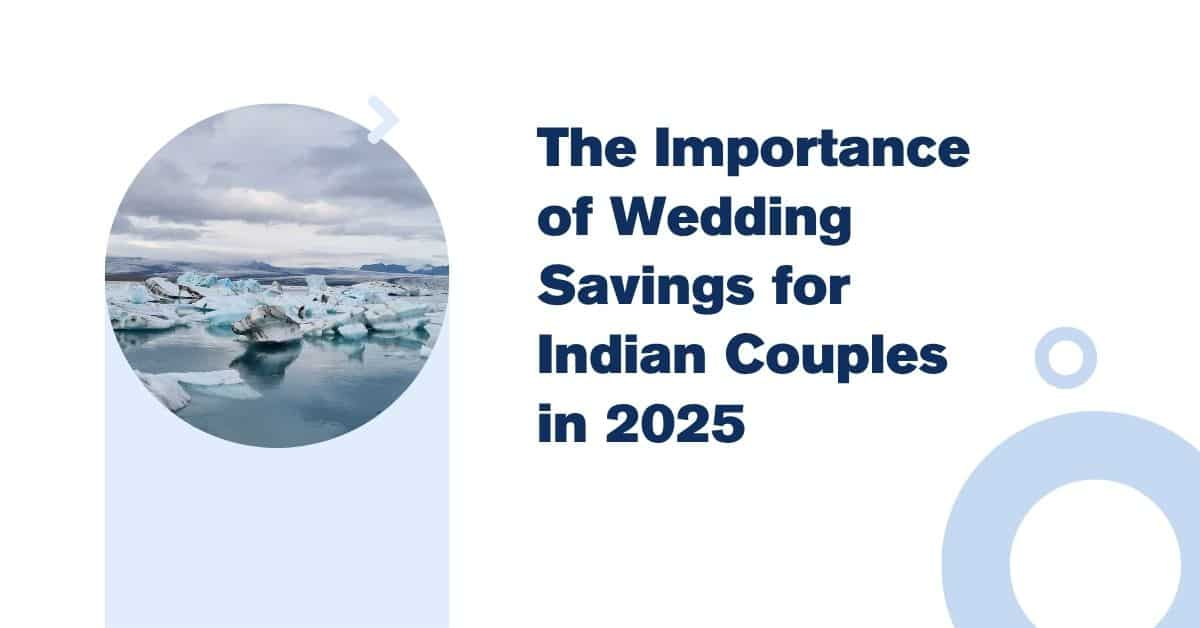7 Smart Saving Tips Every Indian Couple Must Know: As of September 29, 2025, many couples are walking a tightrope when it comes to finances because of India’s inflation rate, which increased from 1.61% in July to 2.07% in August. Due to vacation trends and customised celebrations, the average Indian wedding today costs between ₹25 and 30 lakhs for a middle-class event with 300 guests. Budgets may be strained for soon-to-be married couples, particularly as venue, food, and jewellery account for 40–50% of costs. However, by using wise financial practices, this milestone can be celebrated without stress and without sacrificing happiness.
Over 10 million marriages take place each year in a nation where weddings are cultural extravaganzas, and 30–40% of families frequently end up in debt as a result. Couples can, however, effectively develop a corpus by utilising compounding and tax advantages by implementing disciplined saving strategies. This comprehensive guide provides 7 cost-effective wedding preparation strategies that every Indian couple should be aware of in 2025. We’ll examine each suggestion with practical actions, computations, real-world examples, advantages and disadvantages, and integration with short-term investments that yield returns of 6–8%, all based on current surveys and financial trends. These tactics guarantee financial stability after the wedding, regardless of whether you’re planning a ₹50 lakh big affair or a ₹15 lakh intimate one.
You may counteract the effects of inflation and increase your savings significantly by starting early, ideally one to two years in advance. Let’s get started and pay off your “I do” debt.
The Importance of Wedding Savings for Indian Couples in 2025
In India, weddings are investments in family heritage rather than simply events, but rising expenses—caused by destination weddings, which often cost between ₹25 and ₹70 lakhs—can put a burden on finances. According to a recent report, food and venues account for the majority of typical expenditures, which are ₹29.6 lakhs. Unchecked costs run the risk of causing post-wedding debt for young couples making between ₹50,000 and ₹1 lakh per month, which could impact honeymoons or property purchases.
Advantages of smart saving:

- Inflation Hedge: Savings in high-yield products, such as ultra-short funds (7-7.5%), maintain value at 2.07%.
- Tax Efficiency: Under 80C, plans like PPF or ELSS can save taxes by up to ₹46,800.
- Stress Reduction: Last-minute loans with 10–15% interest are avoided with planned savings.
- Long-Term Wealth: Use wedding expenses as seed money for long-term objectives.
Common mistakes: Include overspending on visitors (₹1,000 per person) or jewellery (20–30% of budget). The 7 things to master are now.
1. Establish a reasonable budget early on and follow it
A thorough budget that breaks down expenses to prevent overruns is the cornerstone of wedding savings.
The Reason It Works
Due to impulsive purchases, Indian weddings frequently go over budget by 20% to 30%. Priorities are first determined using a spreadsheet, with 40% going towards the venue and food, 20% towards the costumes, and 10% going for contingencies.
Comprehensive Steps
- Events on the list: wedding (₹10–15 lakhs), reception (₹5–10 lakhs), and engagement (₹2–5 lakhs).
- For estimates, use applications like WeddingWire.
- Distribute according to income: A maximum of ₹20 lakhs can be earned for a combined salary of ₹75,000.
- Use Excel to track; evaluate every month.
Examples and Calculations
Assuming an objective of ₹25 lakh, save ₹50,000 per month for four years at a 7% RD, which translates to ₹25 lakhs at maturity. For example, a couple from Delhi set aside ₹15 lakhs for their budget and saved ₹3 lakhs by putting their family before extravagance.
Advantages: Promotes cooperation and avoids debt. Cons: Needs self-control. Park in FDs (6–8.25%) to integrate.
2. Reduce the Number of Guests and Choose Smaller Gatherings
Since catering alone costs ₹1,000 per person, fewer guests translate into significant savings.
Specific Advantages
Cutting the number of guests from 500 to 200 saves ₹3-5 lakhs on venue and food costs. For significant events, concentrate on those that are close.
Real-World Application
- Sort into must-have (family) and nice-to-have (friends) categories.
- To save ₹10,000–20,000 on printing, use digital invites.
- Organise combination events: One location for the reception and ceremony.
Impact on the Real World
Instead of having 300 guests, a Hyderabad couple only had 150, saving ₹4 lakhs. 100 fewer visitors at ₹1,000 per person is ₹1 lakh saved; put the money into liquid assets for a 7% yield.
Advantages: Less waste; personal touch. Cons: Pressure from family. Advice: Explain financial limitations politely.
3. Decide on off-season dates and negotiate with suppliers
Timing saves 20–30% on hotels and venues, particularly during off-peak times (May–June, after the holiday).
Comprehensive Analysis
Off-season gives savings, whereas peak season (October to February) drives up prices. Ask about packages that include the venue and décor.
Actions to Take
- Look up dates on Shaadi.com.
- Obtain 3–5 quotes and haggle for 10–15%.
- Get 2025 deals by booking early.
Math and Examples
A couple from Mumbai saved ₹2 lakhs by getting married in May. Venue: ₹5 lakhs peak vs. ₹3 lakhs off; 7% RD saved for a year equals ₹14,000 interest.
Advantages: Availability; cost savings. Cons: Risks from the weather. For short-term bonds (7-9%), use this.
4. Adopt Smart Shopping and Do-It-Yourself Components
DIY clothing and décor can reduce expenses by 15% to 20%; look for sales.
All-inclusive Method
- DIY: family-made favours; invites prepared with Canva (save ₹15,000.
- Purchase: 20% off jewellery online; non-essentials at thrift stores.
Calculations
Clothes The difference between ₹2 lakhs conventional and ₹1 lakh rented/DIY = ₹1 lakh saved; grow in ultra-short funds at 7.5% for 6 months = ₹3,750 interest.
For example, a Bengaluru couple saved ₹50,000 by doing their own décor.
Pros: Fun and unique. Cons: Takes a lot of time.
5. Use High-Return Short-Term Investments to Begin Joint Savings
Using SIPs and FDs, pool incomes for systematic saving.
Why It’s Important
Growth is accelerated by teamwork; short-term investments such as money market funds (6-7.5%) outperform inflation.
A Comprehensive Plan
- Create a joint account with a monthly auto-debit of ₹10,000.
- Options include Treasury bills (6-7%) and RDs (7%).
Growth Estimates
₹20,000 each month for two years at a rate of 7% = ₹5 lakhs. For instance, a Chennai couple employed SIPs to create ₹10 lakhs.
Pros: tax benefits and compounding. Cons: Needs for liquidity.
6. Make Use of Crowdfunding and Wedding Registry Services Conscientiously
Contemporary substitutes for customary presents conserve necessities.
Detailed Usage
- Amazon for home setup and honeymoons is the registry.
- Crowdfund: Milaap accepts donations (saving 10% to 15%).
Advantages Using Examples
Spend less on presents (₹1-2 lakhs). ₹50,000 was crowdfunded by a couple from Kolkata for their trip.
Positives: Useful and interesting. Cons: Taboos in culture.
7. Make a plan for your financial stability after marriage
Save extra for the honeymoon or unexpected expenses.
Long-Term Perspective
Set up 10% for PPF/NPS in the future.
Strategies
- Budget for a honeymoon: ₹2–5 lakhs through savings.
- Avoid debt by avoiding loans at all costs.
A Pune couple, for instance, saved an additional ₹3 lakhs for a down payment on a house.
Holistic planning is a plus. Cons: The impulse to overspend.
Common Mistakes Indian Couples Make When Saving for Their Wedding
- Ignoring inflation Every year, adjust budgets by 5–7%.
- Over-reliance on loans: Savings are eaten up by interest.
- No backup plan: Add a buffer of 10%.
- Pressures from the family: Talk honestly.
Frequently Asked Questions (FAQs)
1. How much does a wedding typically cost in India in 2025?
The middle class pays ₹25-30 lakhs.
2. What is the best short-term wedding savings investment?
7–7.5% for ultra-short funds.
3. How can the invitation list be trimmed without offending anyone?
Set nearby ones as a priority and describe budgets.
4. Wedding savings during the off-season?
20% to 30% on locations.
5. Do wedding savings qualify for tax benefits?
80C thru PPF/ELSS.
Conclusion: A Debt-Free Wedding of Your Dreams
These 7 wise savings suggestions, which range from budgeting to investments at 6-8%, will guarantee a happy beginning for couples getting married in 2025 without having to worry about money. With typical expenses of ₹25–30 lakhs, begin with a collaborative plan right now. Your future self will be appreciative.
Top Saving Accounts in India That Can Grow Your Wealth Fast
How to Save 10 Lakh Before 30 – 5 Proven Strategies That Changes Lives
Metro Life Feels Expensive? Here’s How to Save Money Without Sacrificing Fun

I’m Rashid Ali, a personal finance blogger and content creator at SavingSecret.in, helping young adults in India master saving, investing, and tax planning. I simplify money topics like budgeting, IPO updates, and stock market tips to make finance easy and actionable. Follow me for smart money moves that actually work!
